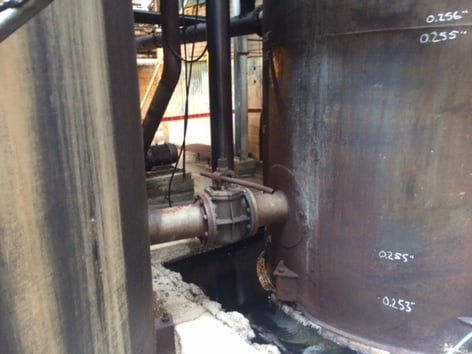Understanding the Key Actions In Tank Welding Inspection Procedures
Understanding the Key Actions In Tank Welding Inspection Procedures
Blog Article

Recognizing the Value of Rigorous Tank Welding Examination Processes in Stopping Failings and Enhancing Lifespan
In the realm of industrial operations, the importance of extensive tank welding examination processes can not be overstated. By executing different evaluation approaches, organizations can spot flaws early, thus avoiding pricey repercussions and prolonging the life of their storage tanks.
Significance of Welding Inspections
Recognizing the critical duty of welding examinations in keeping architectural stability, these processes ensure that welds fulfill well-known requirements and specs - Tank Welding Inspection. Effective welding inspections are extremely important in the building and construction and maintenance of tanks, as they straight affect the sturdiness and safety of the frameworks. By determining potential shortages, such as incorrect techniques or product flaws, evaluations minimize the risk of tragic failures
Welding inspections incorporate various techniques, consisting of visual assessments, non-destructive testing (NDT), and analyses of welding procedures. Each approach serves to validate the high quality and conformity of welds with market laws, consequently protecting both personnel and ecological interests. In addition, regular examinations foster a society of accountability and quality within the workforce, making sure that all employee abide by best methods.
Moreover, these evaluations add to the overall lifecycle administration of containers by recognizing wear or degradation early at the same time. By resolving these problems proactively, organizations can prolong the functional lifespan of their assets, eventually bring about set you back savings and boosted integrity. In recap, the importance of welding inspections can not be overstated; they are important for guaranteeing safety and security, long life, and compliance in storage tank building and upkeep.
Typical Root Causes Of Storage Tank Failures
Comprehending the usual root causes of container failings is crucial for protecting against tragic cases and making certain the long life of storage space systems. One common reason for storage tank failure is corrosion, which can considerably weaken the structural honesty of containers gradually. Environmental elements, such as exposure to dampness, chemicals, and temperature level changes, can accelerate this procedure.
An additional important element is improper welding techniques, which might result in problems like splits or insufficient joints. These problems can compromise the container's stamina and result in leakages or ruptures. In addition, insufficient maintenance techniques can lead to undiscovered damage, eventually enhancing the threat of failing.
Design imperfections, including poor thickness or inadequate material option, can likewise contribute to storage tank vulnerabilities. In addition, operational factors, such as overfilling or direct exposure to extreme stress, can strain the storage tank past its intended restrictions.
Secret Inspection Methods
Effective assessment strategies play an important role in minimizing the dangers connected with storage tank failures. An extensive approach to storage tank welding inspection entails several crucial strategies, each designed to determine prospective issues and ensure structural integrity.
Aesthetic assessment continues to be the first line of defense, enabling examiners to identify surface area anomalies such as cracks, rust, or imbalance. This method is often supplemented by non-destructive testing (NDT) approaches, which are essential for evaluating weld top quality without jeopardizing the container's integrity.

Additionally, magnetic fragment screening (MPT) and dye penetrant testing (DPT) work for finding surface area defects in ferromagnetic materials and non-porous surfaces, specifically. Each method has its staminas and constraints; consequently, a combination of methods is frequently utilized to accomplish detailed assessment outcomes.
Advantages of Extensive Assessments
While the prompt prices of extensive evaluations might appear overwhelming, the lasting advantages dramatically surpass these first financial investments. Applying detailed evaluation processes not only enhances the honesty and safety and security of container frameworks however also minimizes the risk of catastrophic failings that can cause significant monetary losses and environmental this content harm.
Strenuous examinations assist determine potential concerns early in the welding procedure, enabling timely rehabilitative activities that avoid costly fixings or substitutes down the line. This proactive strategy promotes a culture of quality guarantee, where adherence to best techniques ends up being ingrained in functional procedures. Regular assessments contribute to boosted asset long life, as they guarantee that containers stay in optimum condition throughout their life-span.
Additionally, the documents generated from these examinations serves as a beneficial resource for upkeep preparation and performance analyses. This data-driven method can additionally enhance functional performance, resulting in lowered downtime and improved efficiency. Inevitably, rigorous assessments not only protect the structural stability of containers but likewise give substantial economic benefits, enhancing the notion that buying top quality assurance is a wise choice for any kind of company associated with container procedures.
Governing Criteria and Compliance
Governing criteria and compliance are important elements of container welding examination processes, as they develop the structure for ensuring safety and high quality in operations. Conformity with these criteria not just minimizes risks however also enhances the overall integrity of welded structures. Various companies, consisting my company of the American Culture of Mechanical Designers (ASME) and the American Oil Institute (API), give standards that determine appropriate techniques for welding, inspection, and testing.
These standards mandate the use of qualified personnel, the application of strenuous assessment methods, and adherence to details welding treatments. By straightening with governing demands, organizations can ensure that their tanks meet the necessary safety and performance requirements, therefore lowering the chance of tragic failings that can result in considerable financial losses and environmental damages.

Furthermore, regulatory conformity promotes a culture of accountability and continual renovation within the welding and construction industries (Tank Welding Inspection). Regular audits and examinations make sure that methods remain straightened with progressing requirements, thereby advertising long-lasting dependability and functional efficiency. Inevitably, adherence to regulative standards not just safeguards properties however likewise boosts the life expectancy of welded containers, ensuring they offer their designated purpose properly in time
Conclusion
In verdict, extensive tank welding evaluation processes play an essential duty in stopping failings and extending the life-span of storage structures. By recognizing potential deficiencies with different examination methods, organizations can reduce dangers connected with storage tank stability.
Report this page